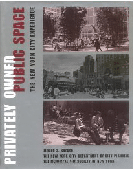
300 Mercer Street
This L-shaped plaza on the east side of Mercer Street and the north side of Waverly Place is replete with built-in concrete seating that is well used during the summer. Circles and curves are the ruling geometric motif. A disk-shaped paving pattern laid into the main portion of the plaza on Waverly Place is echoed in the three high-backed, cone-shaped, concrete planters with benches and two built-in concrete benches in the adjacent arcade. The perimeter planter with sittable ledge undulates sympathetically to the planters and fountain near the street corner.
Access to the space is available at two points. A canopied entrance path for building residents cuts through the northernmost corner of the space from Mercer Street, and a gated entryway from Waverly Place at the southernmost corner is also available. Since the space is required to be open 24 hours a day, the gate is superfluous.
With its plentiful seating, the plaza offers numerous vantage points for studying the historic architecture of the neighborhood. The four smaller buildings southeast across Waverly Place and Broadway display a varied vocabulary of façade embellishment and fenestration, while the massive building across Waverly Place offers impressively rusticated pilasters on its lower floors.


 (5 votes, average: 3.40 out of 5)
(5 votes, average: 3.40 out of 5)
300 Mercer POPS:
This POPS is actually where I spend most of my 15min breaks from work. I’m usually eating an apple on one of the concrete circle benches. The building it’s attached to is uninteresting, but the NYU buildings surrounding make the space a bit cozier. This space acts more of a place for passing through than hanging out for very long. The benches are concrete, and the seats dip in an awkward way—making them uncomfortable. I find it interesting that the visually nicer seating, the benches along the rows of shrubs, is in fact least comfortable. There is no back support for those who want to sit in the area closest to nature. Those backless benches are also oriented in the plaza amongst the foliage giving them a nook-like quality, which, in my opinion, is an important quality of a public space. I can however see that you may run into problems in designing secluded areas for public spaces. It’s foremost a safety hazard, and I suppose POPS are vaguely in support of creating community in semi-“natural” settings. On the other hand, I think it’s also very important to consider public spaces and POPS and how many of them serve as homes for people without. In this sense, I think it’s crucial that these spaces include more sheltering designs than concrete, minimalist layouts. It’s also somewhat insane to me that there’s a zoning law saying that public plazas cannot be located within 175 feet from each other. Public space is being lost as NYC continues to grow, and this is especially scary when many of these artificially “natural” spaces actually are actually considered “green” spaces in the city. Because these public spaces are limited by location, and it’s not like NYC has space to expand outwards, I think it’s dangerous to set restrictions for where they can be, as well as have such a low minimum requirement for quantity of trees per space. If we’re going to set restrictions for how many of these public spaces we can have, we should at least design them to their fullest potential, and I think that starts with vibrant and diverse landscape planning. And hopefully in the near future green roofs will be able to serve as public spaces and parks for urban environments.
Privately Owned Public Space Rules Posted at Site
Landscaping is well-maintained 2017
300 Mercer wraps around a residential building that borders both Mercer Street and Waverly Place, with the inner most portion of the plaza covered by the building itself. The space is inviting with built-in benches forming semi-circles at the plaza’s edge that allow for people to converse with one another while also facing towards the water fountain. There are three circular benches with seats facing outwards, and planters in the middle of the actual structure. No matter where you choose to sit, you will have a great vantage point of the plaza attractions and the people using the space. The sounds from the fountain’s cascading water allows for tranquility by mitigating the noise that from the cars and people passing by. The background noise allows for an easy time reading or decompressing in the middle of one’s workday.
The space is accessible by three points; Waverly Place, Mercer Street and the entrance to the building it surrounds. The coffee shops and pizza parlors that surround the plaza make for easy access to food and drink to bring and enjoy. Planters situated on the edge of the plaza compliment the ones in the middle of the circular benches, together providing nice aesthetic among new York’s high rises. The portion of 300 Mercer that borders Mercer Street is a little more isolated than the part that faces the fountain in that it does not have a center piece in which all the benches are facing. That being said, it is still a nice place to have perhaps a more private conversation or lunch. Overall the space is well maintained and provides a nice ambiance for residents of 300 Mercer, and the general public who use it as a gathering point.
300 Mercer
300 Mercer Picture